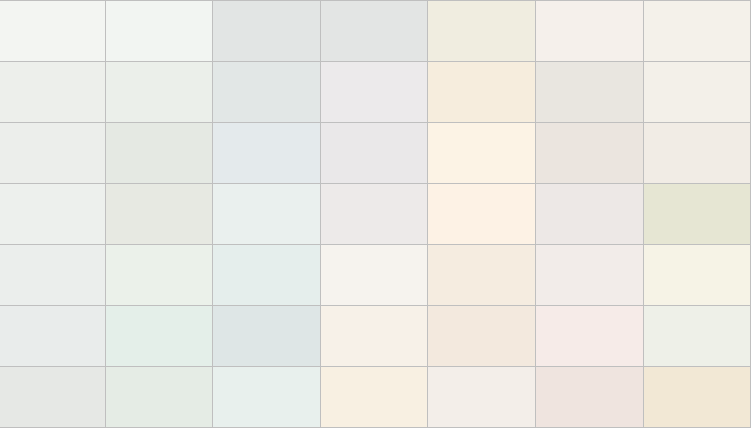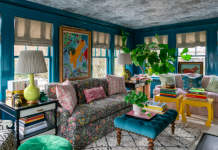White. The timeless color of peace, love, purity, and innocence.
White are the walls of the palaces and grand halls that once housed the French nobility.
White too are the walls of the historic homes of the founding fathers, such as Thomas Jefferson’s Monticello.
And white are the Scandinavian interiors that influence even the most avant-garde interior decorators today.
There’s really no room for discussion; if you want a home that exudes class, distinction, and effortless elegance, your interior color needs to be white.
So that’s settled. You want white. But what shade?
What’s that? White is white? Tout au contraire!
Don’t believe me? This is a selection of paints Benjamin Moore sells as white:
And they have three more pages of white paint swatches! 
See those pinks? And greens? And blues?
A lot of “white” paints carry faint undertones of other colors. The variation is not as striking as this photo would make it seem, but it’s definitely noticeable in person.
The color drift of most uncalibrated computer displays and the distortion of LED backlighting on most phones and laptops makes this distortion even worse.
More so than most colors, the way we perceive white is heavily influenced by what we place around it. Laying a bunch of white swatches on a table, just like placing them side-by-side on a computer screen, creates deceptive illusions of colors and shades that aren’t actually there.
To muddy the waters even more, many cream and lighter tan colors are also labeled and sold as white. Cream paint may look very white at Home Depot or Sherman Williams when you hold the swatch against coordinating colors.
But place that swatch against a real white, like a sheet of copy-paper or enameled white cabinets, and you’ll realize that cream or eggshell paints have a warmer tone with touches of yellow to it.
Table of Contents
5 Steps to Choose the Perfect White
1. Go get swatches. Don’t trust a computer display!
I briefly mentioned this above, but I’ll tell you again: you can’t trust a computer display when picking the right shade of white for your home!
This goes for magazine photos and catalogs too.
Painter’s blogs and Pinterest are wonderful places to find design inspiration. But if you buy your interior paint based only on photos of a certain color, there’s a good chance you’ll be disappointed with the color in person. And that is a very expensive mistake. No major retailer or paint shop will accept returns for custom-mixed paint.
Instead, you should get paint swatches from a reputable paint store or home improvement store with a paint section.
2. Narrow your selection to 3-5 swatches.
Take your color swatches to the room you plan to paint. Don’t lay them all out at once.
Do you remember what I showed you above? The illusion caused by a gallery of white swatches?
That can happen in person too, not just on your screen.
Make a pot of tea. Put on your favorite music. Turn the TV or any computer screens off (the harsh light will distort your perception of the color swatches). Do whatever you do to get relaxed, then pick up your stack of swatches.
Start sorting through them. Make piles of the ones you really like, and the ones you hate. Keep sorting and discarding until you have selected 3-5 favorites.
If your home has decorative molding, you should also pick a complementary shade of white for that. A glossy white is a traditional approach to painting trim and door frames, though some modern interior designers would recommend keeping them the same color as your wall check for gloss paint.
3. Buy samples of your favorite colors.
Once you’ve picked your favorites, it is time to give them a test drive. Sherwin-Williams has a special “Color to Go” product, with a quart of paint in an easy-pouring plastic jar. Many other paint sellers can make similar small batches on request, but rarely advertise it.
Take these jars home, and buy a small (2 inch) paintbrush if you don’t have one.
4. Paint Test-Swatches
Once you have your sample jars at home, pick an open spot on your wall. Tape out a 1ft x 1ft square for each color in you bought a sample of. Be careful not to get any paint on the rug or floor beneath it. A drop cloth works best, but large trash bags connected with painter’s tape works in a pinch, since you only need to protect a small working area beneath each swatch.
The most important part of this test is comparing your colors at different points in the day.
Some whites might look great at night, with table lamps on, but terrible under full sun. Others might look great all through the day, but terrible in the evening. The final selection should be your favorite all-around color.
5. Buy Your Cans and Start Painting
Once you have the perfect shade of white selected, the real work begins!
If you’re dedicated to DIY, you will need to find the square footage of your walls and ceiling first. Then you can calculate how much paint to buy.
This is easy enough with a square room, but trickier if your room is oddly shaped, or the ceiling is sloped.
To find the area of the walls, add the length of each wall, and multiply it by the height of your wall.
For the ceiling, multiply the length and width of the room.
Adding these two numbers together, you have the approximate surface area of the room, less doors, windows, and trim. Unless you have an exceptional number of doors or a whole wall of windows, you don’t need to worry about calculating for the missing space.
As a rule, one gallon of high-quality paint can completely cover up to 350 square feet. So divide your total surface area by 350, and roundup to the nearest whole number. That’s how many gallons of paint you need to buy.
All that math before you can even go to the store!
Next is the real hard work, protecting any furniture and carpets in the room, taping out trim and doors, and brushing out your paint. Hard work alone won’t create a nice-looking paint job. You will need a lot of tools and different rollers and brushes. You also need to be careful to paint everything evenly. If you paint one area too heavily and the other not enough, it will look like you painted over Dalmatian spots.
It’s very easy to spend a lot of money, time, and effort painting a room white, only to step back and hate the finished product. Unless you’re a dedicated DIYer with painting experience, you would do well to find a local house painter who knows what they’re doing and has the tools to do it.
















